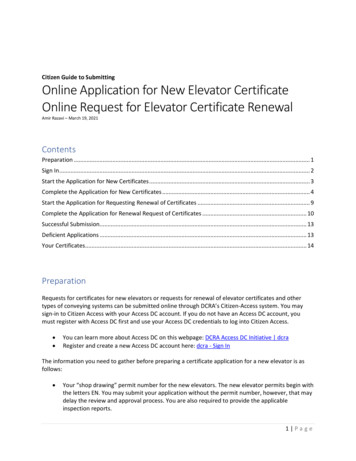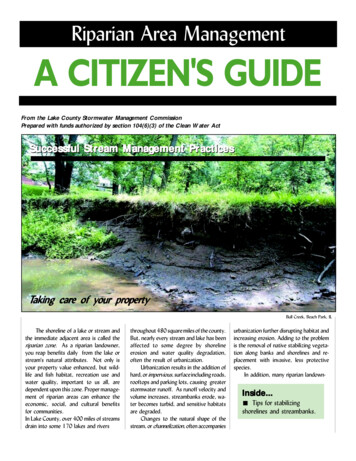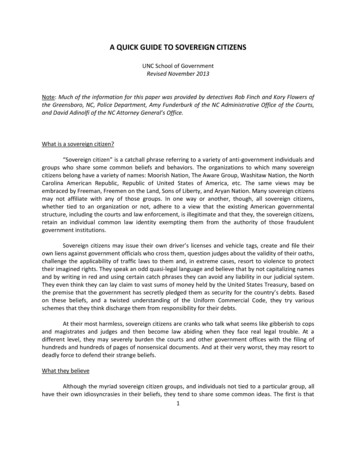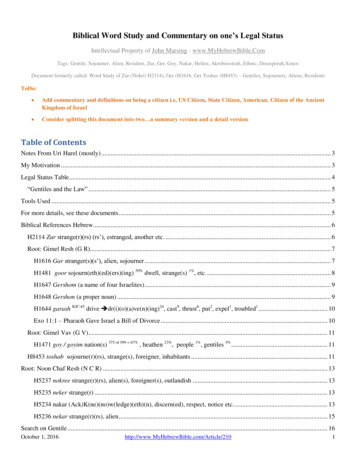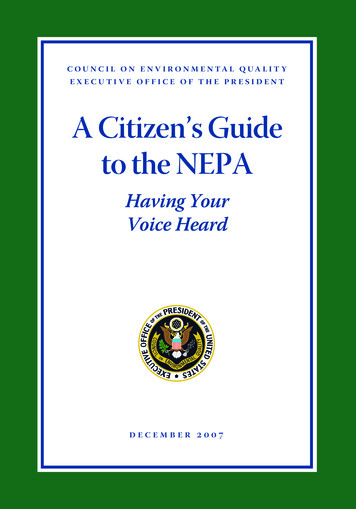
Transcription
c o u n c i l o n e n v i r o n m e n ta l q ua l i t yexecutive office of the presidentA Citizen’s Guideto the NEPAHaving YourVoice Hearddecember 2007
c o u n c i l o n e n v i r o n m e n ta l q ua l i t yexecutive office of the presidentA Citizen’s Guideto the NEPAHaving YourVoice Hearddecember 2007
This guide is based on research and consultations undertaken by the Councilon Environmental Quality (CEQ) concerning the need for a Citizen’s Guideto the National Environmental Policy Act (NEPA). Participants in the NEPARegional Roundtables held in 2003-2004 clearly voiced the need for an guidethat provides an explanation of NEPA, how it is implemented, and howpeople outside the Federal government — individual citizens, private sectorapplicants, members of organized groups, or representatives of Tribal, State,or local government agencies — can better participate in the assessmentof environmental impacts conducted by Federal agencies (see http://ceq.eh.doe.gov/ntf). This guide is informational and does not establish newrequirements. It is not and should not be viewed as constituting formal CEQguidance on the implementation of NEPA, nor are recommendations in thisguide intended to be viewed as legally binding.
Table of ContentsPurpose of the Guide . . . . . . . . . . . . . . . . . . . . . . . . . . . . . . . . . . . . . . . . . . 1History and Purpose of NEPA . . . . . . . . . . . . . . . . . . . . . . . . . . . . . . . . . . 2Who is Responsible for Implementing NEPA?. . . . . . . . . . . . . . . . . . . . . 2To What do the Procedural Requirements of NEPA Apply?. . . . . . . . . 4When Does NEPA Apply?. . . . . . . . . . . . . . . . . . . . . . . . . . . . . . . . . . . . . . 5Who Oversees the NEPA Process?. . . . . . . . . . . . . . . . . . . . . . . . . . . . . . . 5Navigating the NEPA Process . . . . . . . . . . . . . . . . . . . . . . . . . . . . . . . . . . 7Implementing the NEPA Process . . . . . . . . . . . . . . . . . . . . . . . . . . . . . . . 10Categorical Exclusions (CE). . . . . . . . . . . . . . . . . . . . . . . . . . . . . . . 10Environmental Assessments (EA). . . . . . . . . . . . . . . . . . . . . . . . . . 11Environmental Impact Statements (EIS). . . . . . . . . . . . . . . . . . . . . 13Notice of Intent and Scoping. . . . . . . . . . . . . . . . . . . . . . . . . . . . . . 13Draft EIS . . . . . . . . . . . . . . . . . . . . . . . . . . . . . . . . . . . . . . . . . . . . . . . 16Final EIS. . . . . . . . . . . . . . . . . . . . . . . . . . . . . . . . . . . . . . . . . . . . . . . . 18Record of Decision (ROD) . . . . . . . . . . . . . . . . . . . . . . . . . . . . . . . . 19Supplemental EIS. . . . . . . . . . . . . . . . . . . . . . . . . . . . . . . . . . . . . . . . 20EPA’s Review . . . . . . . . . . . . . . . . . . . . . . . . . . . . . . . . . . . . . . . . . . 21When and How to Get Involved. . . . . . . . . . . . . . . . . . . . . . . . . . . . . . . . 21It Depends on the Agency . . . . . . . . . . . . . . . . . . . . . . . . . . . . . . . . 21Be Informed of Actions. . . . . . . . . . . . . . . . . . . . . . . . . . . . . . . . . . . 23Active Involvement. . . . . . . . . . . . . . . . . . . . . . . . . . . . . . . . . . . . . . 23Other Processes that Require Public Involvement. . . . . . . . . . . . 25How to Comment. . . . . . . . . . . . . . . . . . . . . . . . . . . . . . . . . . . . . . . . 27What If Involvement Isn’t Going Well?. . . . . . . . . . . . . . . . . . . . . . . . . . 28Don’t Wait Too Long. . . . . . . . . . . . . . . . . . . . . . . . . . . . . . . . . . . . . 28Contact the Agency. . . . . . . . . . . . . . . . . . . . . . . . . . . . . . . . . . . . . . 28Having Your Voice Heardi
Other Assistance. . . . . . . . . . . . . . . . . . . . . . . . . . . . . . . . . . . . . . . . . 29NEPA’s Requirements . . . . . . . . . . . . . . . . . . . . . . . . . . . . . . . . . . . 29Remedies Available. . . . . . . . . . . . . . . . . . . . . . . . . . . . . . . . . . . . . . 30Final Thoughts. . . . . . . . . . . . . . . . . . . . . . . . . . . . . . . . . . . . . . . . . . . . . . . 30List of AppendicesAppendix A: NEPAnet and How to Use ItAppendix B: The Federal Register and How to Use ItAppendix C: EPA’s EIS Rating SystemAppendix D: Agency NEPA ContactsAppendix E: Some Useful Definitions from the Council onEnvironmental Quality NEPA ImplementingRegulationsList of OD:iiCategorical ExclusionCouncil on Environmental QualityCode of Federal RegulationsEnvironmental AssessmentEnvironmental Impact StatementEnvironmental Management SystemThe Environmental Protection AgencyFinding of No Significant ImpactThe National Environmental Policy ActNotice of IntentRecord of DecisionA C itizen ’ s G uideto theNEPA
Purpose of the GuideThis guide has been developed to help citizens and organizationswho are concerned about the environmental effects of federaldecisionmaking to effectively participate in Federal agencies’environmental reviews under the National Environmental PolicyAct (NEPA).1 With some limited exceptions, all Federal agencies inthe executive branch have to comply with NEPA before they makefinal decisions about federal actions that could have environmentaleffects. Thus, NEPA applies to a very wide range of federal actionsthat include, but are not limited to, federal construction projects, plansto manage and develop federally owned lands, and federal approvalsof non-federal activities such as grants, licenses, and permits. TheFederal Government takes hundreds of actions every day that are, insome way, covered by NEPA.The environmental review process under NEPA providesan opportunity for you to be involved in the Federal agencydecisionmaking process. It will help you understand what theFederal agency is proposing, to offer your thoughts on alternativeways for the agency to accomplish what it is proposing, and to offeryour comments on the agency’s analysis of the environmental effectsof the proposed action and possible mitigation of potential harmfuleffects of such actions. NEPA requires Federal agencies to considerenvironmental effects that include, among others, impacts on social,cultural, and economic resources, as well as natural resources.Citizens often have valuable information about places and resourcesthat they value and the potential environmental, social, and economiceffects that proposed federal actions may have on those places andresources. NEPA’s requirements provide you the means to work withthe agencies so they can take your information into account.National Environmental Policy Act of 1969, as amended, 42 U.S.C. §§ 4321-4347, available atwww.nepa.gov.1Having Your Voice Heard1
History and Purpose of NEPACongress enacted NEPA in December, 1969, and President Nixonsigned it into law on January 1, 1970. NEPA was the first majorenvironmental law in the United States and is often called the “MagnaCarta” of environmental laws. Importantly, NEPA established thiscountry’s national environmental policies.To implement these policies, NEPA requires agencies to undertakean assessment of the environmental effects of their proposed actionsprior to making decisions. Two major purposes of the environmentalreview process are better informed decisions and citizen involvement,both of which should lead to implementation of NEPA’s policies.Who is Responsible for Implementing NEPA?Every agency in the executive branch of the Federal Government has aresponsibility to implement NEPA. In NEPA, Congress directed that,to the fullest extent possible, the policies, regulations, and public lawsof the United States shall be interpreted and administered in accordancewith the policies set forth in NEPA.2 To implement NEPA’s policies,Congress prescribed a procedure, commonly referred to as “the NEPAprocess” or “the environmental impact assessment process.”NEPA’s procedural requirements apply to all Federal agencies in theexecutive branch. NEPA does not apply to the President, to Congress,or to the Federal courts.3Because NEPA implementation is an important responsibility of theFederal Government, many Federal agencies have established officesdedicated to NEPA policy and program oversight. Employees inthese offices prepare NEPA guidance, policy, and procedures forthe agency, and often make this information available to the publicthrough sources such as Internet websites. Agencies are requiredto develop their own capacity within a NEPA program in order todevelop analyses and documents (or review those prepared by others)to ensure informed decisionmaking.4 Most agency NEPA proceduresare available on-line at the NEPAnet website m). Agency NEPA procedures are published inSection 102 of the National Environmental Policy Act of 1969, 42 U.S.C. §4332.CEQ NEPA Regulations 40 C.F.R.§1508.12.4Council on Environmental Quality , “Regulations for Implementing the Procedural Provisions of theNational Environmental Policy Act” 40 C.F.R. section 1507.2, available at www.nepa.gov. Future referencesto the CEQ NEPA Regualtions will be cited as : CEQ NEPA Regulations, 40 C.F.R. §1507.2.232A C itizen ’ s G uideto theNEPA
National Environmental Policy Act Sec. 101[42 USC § 4331](a) The Congress, recognizing the profound impact of man’s activityon the interrelations of all components of the natural environment,particularly the profound influences of population growth, high-densityurbanization, industrial expansion, resource exploitation, and newand expanding technological advances and recognizing further thecritical importance of restoring and maintaining environmental qualityto the overall welfare and development of man, declares that it is thecontinuing policy of the Federal Government, in cooperation withState and local governments, and other concerned public and privateorganizations, to use all practicable means and measures, includingfinancial and technical assistance, in a manner calculated to foster andpromote the general welfare, to create and maintain conditions underwhich man and nature can exist in productive harmony, and fulfillthe social, economic, and other requirements of present and futuregenerations of Americans.(b) In order to carry out the policy set forth in this Act, it is thecontinuing responsibility of the Federal Government to use allpracticable means, consistent with other essential considerations ofnational policy, to improve and coordinate Federal plans, functions,programs, and resources to the end that the Nation may —1. fulfill the responsibilities of each generation as trustee of theenvironment for succeeding generations;2. assure for all Americans safe, healthful, productive, andaesthetically and culturally pleasing surroundings;3. attain the widest range of beneficial uses of the environmentwithout degradation, risk to health or safety, or otherundesirable and unintended consequences;4. preserve important historic, cultural, and natural aspectsof our national heritage, and maintain, wherever possible,an environment which supports diversity, and variety ofindividual choice;5. achieve a balance between population and resource usewhich will permit high standards of living and a widesharing of life’s amenities; and6. enhance the quality of renewable resources and approachthe maximum attainable recycling of depletable resources.(c) The Congress recognizes that each person should enjoy a healthfulenvironment and that each person has a responsibility to contribute tothe preservation and enhancement of the environment.Having Your Voice Heard3
the Federal Register for public review and comment when firstproposed and some are later codified and published in the Code ofFederal Regulations.5 If you experience difficulty locating an agency’sNEPA procedures, you can write or call the agency NEPA point ofcontacts and ask for a copy of their procedures.6To What Do the Procedural Requirementsof NEPA Apply?In NEPA, Congress recognized that the Federal Government’s actionsmay cause significant environmental effects. The range of actions thatcause significant environmental effects is broad and includes issuingregulations, providing permits for private actions, funding privateactions, making federal land management decisions, constructingpublicly-owned facilities, and many other types of actions. Using theNEPA process, agencies are required to determine if their proposedactions have significant environmental effects and to consider theenvironmental and related social and economic effects of theirproposed actions.NEPA’s procedural requirements apply to a Federal agency’sdecisions for actions, including financing, assisting, conducting, orapproving projects or programs; agency rules, regulations, plans,policies, or procedures; and legislative proposals.7 NEPA applieswhen a Federal agency has discretion to choose among one or morealternative means of accomplishing a particular goal.8Frequently, private individuals or companies will become involvedin the NEPA process when they need a permit issued by a Federalagency. When a company applies for a permit (for example, forcrossing federal lands or impacting waters of the United States) theagency that is being asked to issue the permit must evaluate theenvironmental effects of the permit decision under NEPA. Federalagencies might require the private company or developer to pay forthe preparation of analyses, but the agency remains responsible forthe scope and accuracy of the analysis.The draft agency implementing procedures, or regulations, are published in the Federal Register, anda public comment period is required prior to CEQ approval. Commenting on these agency regulationsis one way to be involved in their development. Most agencies already have implementing procedures;however, when they are changed, the agency will again provide for public comment on the proposedchanges.6See Appendices A and D for information on how to access agency points of contact and agency websites.7CEQ NEPA Regulations, 40 C.F.R. § 1508.18. Note that this section applies only to legislation draftedand submitted to Congress by federal agencies. NEPA does not apply to legislation initiated by membersof Congress.8CEQ NEPA Regulations, 40 C.F.R. § 1508.23.54A C itizen ’ s G uideto theNEPA
When Does NEPA Apply?NEPA requires agency decisionmakers to make informed decisions.Therefore, the NEPA process must be completed before an agencymakes a final decision on a proposed action. Good NEPA analysesshould include a consideration of how NEPA’s policy goals (Section101) will be incorporated into the decision to the extent consistentwith other considerations of national policy. NEPA does not requirethe decisionmaker to select the environmentally preferable alternativeor prohibit adverse environmental effects. Indeed, decisionmakers inFederal agencies often have other concerns and policy considerationsto take into account in the decisionmaking process, such as social,economic, technical or national security interests. But NEPA doesrequire that decisionmakers be informed of the environmentalconsequences of their decisions.The NEPA process can also serve to meet other environmental reviewrequirements. For instance, actions that require the NEPA processmay have an impact on endangered species, historic properties, orlow income communities. The NEPA analysis, which takes intoaccount the potential impacts of the proposed action and investigatesalternative actions, may also serve as a framework to meet otherenvironmental review requirements, such as the Endangered SpeciesAct, the National Historic Preservation Act, the Environmental JusticeExecutive Order, and other Federal, State, Tribal, and local laws andregulations.9Who Oversees the NEPA Process?There are three Federal agencies that have particular responsibilitiesfor NEPA. Primary responsibility is vested in the Council onEnvironmental Quality (CEQ), established by Congress in NEPA.Congress placed CEQ in the Executive Office of the President andgave it many responsibilities, including the responsibility to ensurethat Federal agencies meet their obligations under the Act. CEQoversees implementation of NEPA, principally through issuance andinterpretation of NEPA regulations that implement the proceduralrequirements of NEPA. CEQ also reviews and approves Federalagency NEPA procedures, approves of alternative arrangementsfor compliance with NEPA in the case of emergencies, and helpsto resolve disputes between Federal agencies and with othergovernmental entities and members of the public.9CEQ NEPA Regualtions, 40 C.F.R. § 1502.25.Having Your Voice Heard5
In 1978, CEQ issued binding regulations directing agencies onthe fundamental requirements necessary to fulfill their NEPAobligations.10 The CEQ regulations set forth minimum requirementsfor agencies. The CEQ regulations also called for agencies to createtheir own implementing procedures that supplement the minimumrequirements based on each agency’s specific mandates, obligations,and missions.11 These agency-specific NEPA procedures account forthe slight differences in agencies’ NEPA processes.The Environmental Protection Agency’s (EPA) Office of FederalActivities reviews environmental impact statements (EIS) and someenvironmental assessments (EA) issued by Federal agencies.12 Itprovides its comments to the public by publishing summaries of themin the Federal Register, a daily publication that provides notice ofFederal agency actions.13 EPA’s reviews are intended to assist Federalagencies in improving their NEPA analyses and decisions.14Another government entity involved in NEPA is the U.S. Institutefor Environmental Conflict Resolution, which was established by theEnvironmental Policy and Conflict Resolution Act of 1998 to assistin resolving conflict over environmental issues that involve Federalagencies.15 While part of the Federal Government (it is located withinthe Morris K. Udall Foundation, a Federal agency located in Tucson,Arizona), it provides an independent, neutral, place for Federalagencies to work with citizens as well as State, local, and Tribalgovernments, private organizations, and businesses to reach commonground. The Institute provides dispute resolution alternatives tolitigation and other adversarial approaches. The Institute is alsocharged with assisting the Federal Government in the implementationof the substantive policies set forth in Section 101 of NEPA.16CEQ NEPA Regulations, 40 C.F.R. parts 1500-1508, available at www.nepa.gov.CEQ NEPA Regualations, 40 C.F.R. § 1507.3.12Clean Air Act, 42 U.S.C. § 7609.13See Appendix B for information on the Federal Register.14For additional infomation see ironmental Policy and Conflict Resolution Act of 1998, 20 U.S.C. §§ 5601-5609.16For a discussion of the relationship between Section 101 of NEPA and conflict resolution, includingspecific case examples and recommendations for strengthening that relationship see the NationalEnvironmental Conflict Resolution Advisory Committee, “Final Report — Submitted to the U.S. Institutefor Environmental Conflict Resolution of the Morris K. Udall Foundation,” (April 2005), available athttp://www.ecr.gov by clicking on “Resources” and “NEPA and ECR.”.10116A C itizen ’ s G uideto theNEPA
Navigating the NEPA ProcessEach year, thousands of Environmental Assessments (EAs) andhundreds of Environmental Impact Statements (EISs) are prepared byFederal agencies. These documents provide citizens and communitiesan opportunity to learn about and be involved in each of thoseenvironmental impact assessments that are part of the Federalagency decisionmaking process. It is important to understand thatcommenting on a proposal is not a “vote” on whether the proposedaction should take place. Nonetheless, the information you provideduring the EA and EIS process can influence the decisionmakersand their final decisions because NEPA does require that federaldecisionmakers be informed of the environmental consequences oftheir decisions.This guide will help you better navigate through the NEPA processand better understand the roles of the various other actors. Whilereading the guide, please refer to the following flowchart, “The NEPAProcess,” which details the steps of the NEPA process. For easeof reference, each step of the process is designated with a numberwhich is highlighted in the text discussing that particular step.While agencies may differ slightly in how they comply with NEPA,understanding the basics will give you the information you need towork effectively with any agency’s process.Having Your Voice Heard7
The NEPA Process1. Agency Identifies a Need for Actionand Develops a Proposal2. Are Environmental Effects Likelyto Be Significant?NO3. Proposed Actionis Described inAgency CategoricalExclusion (CE)YESNOYESYES5. SignificantEnvironmentalEffects Uncertain orNo Agency CE8. SignificantEnvironmentalEffects May orWill Occur9. Notice ofintent to prepareEnvironmental ImpactStatement (EIS)6. DevelopEnvironmentalAssessment(EA) with PublicInvolvement to theExtent PracticableYES4. Does the ProposalHave lEffects?NONO10. Public Scopingand AppropraitePublic Involvement11. Draft EIS12. Public Reviewand Comment andAppropriate PublicInvolvement7. Finding of NoSignificant Impact13. Final EIS14. PublicAvailability of FEISDecision15. Record ofDecisionImplementation with Monitoring as Provided in the Decision*Significant new circumstances or information relevant to environmental concerns orsubstantial changes in the proposed action that are relevant to environmental concerns maynecessitate preparation of a supplemental EIS following either the draft or final EIS or theRecord of Decision (CEQ NEPA Regulations, 40 C.F.R. § 1502.9(c)).8A C itizen ’ s G uideto theNEPA
The NEPA process begins when an agency develops a proposal toaddress a need to take an action.The need to take an action may be something the agency identifiesitself, or it may be a need to make a decision on a proposal brought toit by someone outside of the agency, for example, an applicant for apermit. Based on the need, the agency develops a proposal for action(Number 1 in Figure 1). If it is the only Federal agency involved, thatagency will automatically be the “lead agency,” which means it hasthe primary responsibility for compliance with NEPA.Some large or complex proposals involve multiple Federal agenciesalong with State, local, and Tribal agencies. If another Federal,State, local, or Tribal agency has a major role in the proposed actionand also has NEPA responsibilities or responsibilities under asimilar NEPA-like law17, that agency may be a “joint lead agency.”A “joint lead agency” shares the lead agency’s responsibility formanagement of the NEPA process, including public involvementand the preparation of documents. Other Federal, State, Tribal, orlocal government agencies may have a decision or special expertiseregarding a proposed action, but less of a role than the lead agency.In that case, such a Federal, State, Tribal, or local government agencymay be a “cooperating agency.”A “cooperating agency” is an agency that has jurisdiction by law orspecial expertise with respect to any environmental impact involvedin a proposal (or a reasonable alternative). Thus, a “cooperatingagency” typically will have some responsibilities for the analysisrelated to its jurisdiction or special expertise.Once it has developed a proposed action, the agency will enter theinitial analytical approach (Number 2 in Figure 1) to help it determinewhether the agency will pursue the path of a Categorical Exclusion(CE), an Environmental Assessment (EA), or an Environmental ImpactStatement (EIS).About a quarter of the states have such laws; for example, New York, Montana, Washington, andCalifornia all have such laws. New York City also has such a law. A list with references is available atwww.nepa.gov by clicking on “State Information” or directly at http://ceq.eh.doe.gov/nepa/states.html.17Having Your Voice Heard9
Special Situationsv On rare occasions, Congress may exempt an action from NEPA.v If the agency needs to take an action that would typically requirepreparation of an environmental impact statement in response toan emergency, and there is insufficient time to follow the regularNEPA process, then the agency can proceed immediately tomitigate harm to life, property, or important resources, and workwith CEQ to develop alternative arrangements for compliance withNEPA (40 C.F.R. §1506.11).v The NEPA analyses and document may involve classifiedinformation. If the entire action is classified, the agency willstill comply with the analytical requirements of NEPA, but theinformation will not be released for public review. If only aportion of the information is classified, the agency will organizethe classified material so that the unclassified portions can be madeavailable for review (40 C.F.R. §1507.3(c)).Implementing the NEPA ProcessCategorical Exclusions (CEs) (Number 3 in Figure 1)A CE is a category of actions that the agency has determined does notindividually or cumulatively have a significant effect on the quality ofthe human environment.18 Examples include issuing administrativepersonnel procedures, making minor facility renovations (such asinstalling energy efficient lighting), and reconstruction of hikingtrails on public lands. Agencies develop a list of CEs specific to theiroperations when they develop or revise their NEPA implementingprocedures in accordance with CEQ’s NEPA regulations.A CE is based on an agency’s experience with a particular kindof action and its environmental effects. The agency may havestudied the action in previous EAs, found no significant impact onthe environment based on the analyses, and validated the lack ofsignificant impacts after the implementation. If this is the type ofaction that will be repeated over time, the agency may decide toamend their implementing regulations to include the action as a CE.In these cases, the draft agency procedures are published in the FederalRegister, and a public comment period is required. Participation inthese comment periods is an important way to be involved in thedevelopment of a particular CE.1810CEQ NEPA Regulations, 40 C.F.R. § 1508.4.A C itizen ’ s G uideto theNEPA
If a proposed action is included in the description provided for alisted CE established by the agency, the agency must check to makesure that no extraordinary circumstances exist that may cause theproposed action to have a significant effect in a particular situation.Extraordinary circumstances typically include such matters as effectsto endangered species, protected cultural sites, and wetlands (Number4 in Figure 1). If there are no extraordinary circumstances indicatingthat the effects of the action may be significant, then the agency canproceed with the action.If the proposed action is not included in the description providedin the CE establised by the agency, or there are extraordinarycircumstances, the agency must prepare an EA or an EIS, or developa new proposal that may quality for application of a CE. When theagency does not know or is uncertain whether significant impacts areexpected, the agency should prepare an EA to determine if there aresignificant environmental effects.Environmental Assessments (EA) (Number 5 in Figure 1)The purpose of an EA is to determine the significance of theenvironmental effects and to look at alternative means to achieve theagency’s objectives. The EA is intended to be a concise document that(1) briefly provides sufficient evidence and analysis for determiningwhether to prepare an EIS; (2) aids an agency’s compliance withNEPA when no environmental impact statement is necessary; and (3)facilitates preparation of an Environmental Impact Statement whenone is necessary.19An EA should include brief discussions of:v the need for the proposal,v alternative courses of action for any proposal whichinvolves unresolved conflicts concerning alternativeuses of available resources,v the environmental impacts of the proposed action andalternatives, andv a listing of agencies and persons consulted.201920CEQ NEPA Regulations, 40 C.F.R. § 1508.9.CEQ NEPA Regulations, 40 C.F.R. § 1508.9(b).Having Your Voice Heard11
Because the EA serves to evaluate the significance of a proposalfor agency actions, it should focus on the context and intensityof effects that may “significantly” affect the quality of the humanenvironment.21 Often the EA will identify ways in which the agencycan revise the action to minimize environmental effects.When preparing an EA, the agency has discretion as to the level ofpublic involvement (Number 6 in Figure 1). The CEQ regulationsstate that the agency shall involve environmental agencies,applicants, and the public, to the extent practicable, in preparingEAs.22 Sometimes agencies will choose to mirror the scoping andpublic comment periods that are found in the EIS process. In othersituations, agencies make the EA and a draft FONSI available tointerested members of the public.Some agencies, such as the Army, require that interested parties benotified of the decision to prepare an EA, and the Army also makesthe EA publicly available. Some agencies keep a notification list ofparties interested in a particular kind of action or in all agency actions.Other agencies simply prepare the EA. Not all agencies systematicallyprovide information about individual EAs, so it is important that youread the specific implementing procedures of the proposing agencyor ask the local NEPA point of contact working on the project aboutthe process and let the appropriate agency representative know ifyou are interested in being notified of all NEPA documents or NEPAprocesses related to a particular type of action.The EA process concludes with either a Finding of No SignificantImp
Having Your Voice Heard i Table of Contents Purpose of the Guide .1 History and Purpose of NEPA . . . . . . . . . . . . . . . . . . . . . . . . . . . . . . . . . .2



